Retention, or why the user will return to the game?
Hi, Habr!
I have always been interested in gamedev. A few years ago, I took a step and plunged into this world. I was amazed at the success of Angry Birds, the rise and fall of Zynga, and one thought kept me awake - “How did they make such great games?”.
A lot of time passed, a box of experience accumulated,some fragmentary notes and comments formed in the bins. I decided to structure and systematize everything, trying to answer one of the key questions - “Why does the user return to the game?”.
Since there is a lot of material, I decided to split it into two parts. If the topic is interesting - the second part will be released in a week.
')
So often it happens - you try a new game and turn it off in half an hour. "Not tightened" - spinning in my head and did not want to return. But after all, the graphics are cool, the setting is a favorite, and it seems it was not boring ... What could be wrong here?
For social (and not only social) games, there is such a characteristic as retention. In other words - the ability to keep the player in the gameplay. Retention is one of the most important parameters of any social game, along with virality and the ability to monetize. For developers of freemium games, this indicator is extremely important, since it directly affects their income, but for all others, the retention will affect the success of sales of sequels of the game.
Retention shows how many users who started playing today will return to the game tomorrow. Retention cannot be overlooked if you plan to get good statistics on daily and monthly visits and in-game purchases.
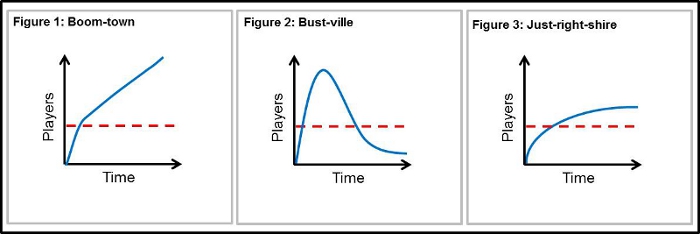
Such different ideal scenarios of the game. We will talk about them in the following articles.
For social and mobile games, the retention is considered to be the DAU / MAU formula, (the sum of active users per day / the sum of active users per month), many consider this indicator to be an indicator of the “potential” of the game. It is also customary to distinguish between daily, weekly and monthly retention. If we talk about acceptable numbers, you can listen to the opinion of Henric Suuronen, the former head of the company Woog (Wooga), which released several hits for Facebook. His opinion - if the daily retention of the game exceeds 40%, the weekly 20% and the monthly 10%, then the game has a happy future.
Earlier, in the era of non-social or extra-social games, there was no need forany level of retention. Yes, if you wanted to return to the game, go through it again - this will indirectly affect future sales. Now, when players on mobile platforms and social networks get games for free, developers need to sell something inside the game. And this can be done only when the user devotes time to the game, at least the most minimal. If a user logged in once and does not want to return - what is the chance that he will buy something inside the game? Of course, such a chance is negligible. But if the user enters the game daily, he sees a direct meaning to buy something in the game. This means that a high level of retention directly affects the income from the game. No matter how sophisticated and perfect the monetization system is, it is unlikely that it will bring substantial revenue to only one-time users. What methods of increasing retention exist?
A small warning: it’s not a good idea to useall-all-all elements of increasing retention in one product. If the user feels overwhelming, feels that he is almost dragged into the game by force, he most likely will not return or will ignore even the most effective methods.
People love characters and become attached to them. They are interested in what happens to them during the game. A similar feeling makes us look forward to a new and new series of the series. Like TV shows, we are ready to return to the game again and again and learnsomething new in the script, characters and game world. Even if you control a character, this does not mean that you are not interested in what happens next.

Mrs. President of Army Attack gives us a new mission
The game should show the user what exactly he has not done in the game at any time the gameplay. A self-reminding task encourages the user to return and complete it. These tasks show the player all the possibilities of the game, serve as a guide, assistant. It is only important to find a middle ground in the number and speed of submission of new tasks - if there are too few tasks, the user can get stuck onsomething and quit the game due to the inability to complete this or that moment. If there are too many tasks, the user can lose focus, drown in all variety and leave without understanding what the authors of the game wanted from him.
It is also impossible to forget about the quality of such tasks - they must be executable and clearly measured. The quest “Become the King”, appearing at the very beginning of the game does not stimulate the user, but only pushes him away, showing that the goal is unattainable in the foreseeable future. A quest in which it is necessary to “catch the frogs until the witch fills the chest with them” is unlikely to stimulate the player if he does not know how many frogs he needs, because it can be three frogs, and five hundred.
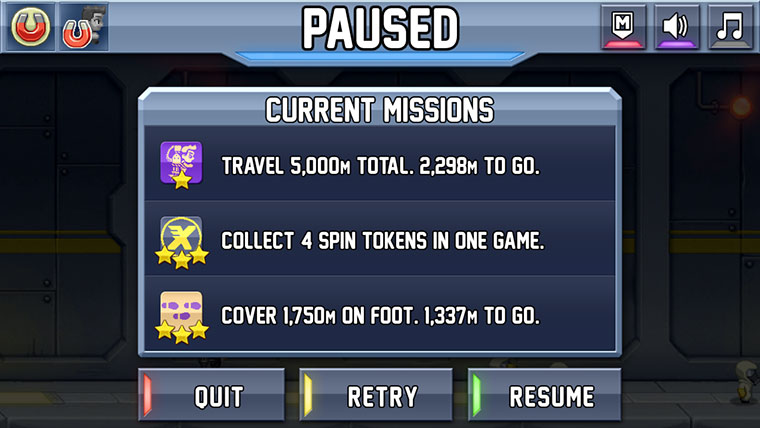
Jetpack Joyride not only gives quests, but also shows my current progress in them.
The game should show the user his path in the game, his achievements and deeds. Collecting, the desire to collect and keep firmly instilled in many people of European and Western cultural traditions. Property, loot, collections, awards, achievements show the user his progress, his accumulated efforts. Levels, skins, and unique uniforms that were hard-won in very deep dungeons are also an excellent motivator for getting back into the game. In this regard, you can play on the peculiarities of human psychology - the more difficult it gets the object (status, rank, etc. ), the more he appreciates it, even though the obstacles may even be contrived, the payment is too high, and uncomfortable.
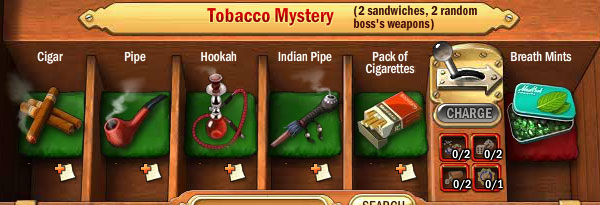
The collection of the connoisseur of smoking from the Mystery Menor (Mystery Manor)
The game, if possible, should limit the maximum supply of self-replicating resources and should require even the most trivial tasks the slightest attention to themselves. The player must understand that giving the game at least a fraction of the attention he will receive much more advantages. If there are no restrictions in the game, the player will be able to postpone indefinitely his return and may soon forget about the game. For this purpose, the limit of energy, the limit of resources and other joys of the game are realized. As a result, in order not to miss the opportunity to receive additional bonuses, the player returns to the game to perform routine actions, such as collecting gold from their houses. It would seem, for convenience, you can automate the process and automatically transfer the accumulated amount. But behind this "optimization" lies the serious problem of retention.
Optimization result:

Zinga is also mistaken - after a year of absence in the game I became fabulously rich
Initially, in Mafia Wars, passively earned money was immediately transferred to the account. As a result, it was possible for months not to attend the game in order to accumulate billions and the number of "candy wrappers" in the account lost all meaning.
But the game requires a click and collectall sorts of things from each house:

The Simpsons: Tapped Out (EA) , a game based on the Simpsons, quite well in the gameplay
The game should show that the world itself lives beyond the user's time, and regular presence in the game promises additional dividends for it. This element is a logical development of the previous element. With the help of regular events, such as lotteries, weekly tournaments, the user can develop the habit of returning to the game. The user likes to participate in the events, he feels that he does not miss a single opportunity to dosomething in the game. In addition, if the reward for permanent participation in such events will help the player in the main game process, this will add another factor to return.
A good example of the implementation of weekly tournaments:
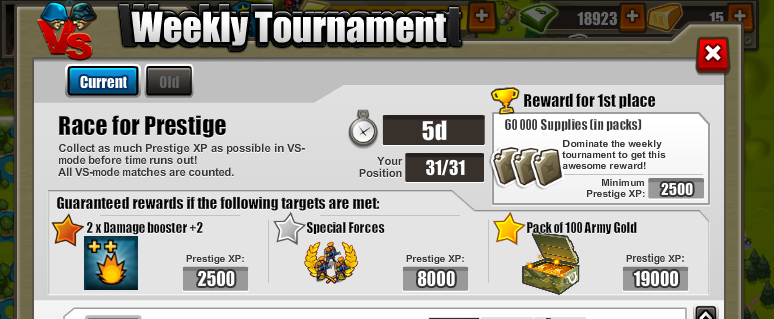
You can get valuable gifts by participating in such tournaments.
There is also a reward for participating in the tournament, and a global expensive prize. In addition, the current place of the participant of the tournament and the remaining time is indicated.
The system of invitations and social connections should show the user that his friends need him. Responsibility to friends spurs the player back and help them dosomething for the benefit of themselves and others. In addition, there is also in-game pressure on the user in the form of calls and text messages "Please come for a second, throw off a single copper ingot, I don’t have enough to collect new armor." The easier it is for the user to draw friends into the game, the more opportunities to create a favorable atmosphere, the less the user will want to abandon the game or switch to another. Mechanisms of interaction with friends are also beneficial because they provide an opportunity for the work of viral mechanisms, which we will discuss in another article.
In addition, competition is important for many users - stimulate it with the help of ratings and competitions. Make a global ranking for experienced players and a few “leagues” - local rankings based on additional features. The more such leagues, the greater the chance of the player to getany prize and honor. Particular attention should be paid to the organization of the novice league and the league of friends - when a new player sees a real opportunity to enter the local pedestal he will have more reasons to pay attention to the game in the future. Remember that the rating system motivates only the top 10–20% of participants.
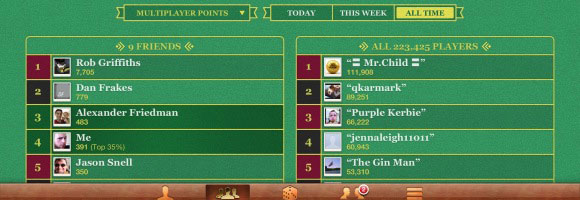
Initially, several types of ratings are included in the Game Center (Game Center), including a breakdown into a rating among friends and overall ratings.
In the second part, I will continue this inexhaustible list of tools for increasing retention. There you can read how the player is affected by the mystery, why the game is probable and what is the depth of the game and the game turn.
I have always been interested in gamedev. A few years ago, I took a step and plunged into this world. I was amazed at the success of Angry Birds, the rise and fall of Zynga, and one thought kept me awake - “How did they make such great games?”.
A lot of time passed, a box of experience accumulated,
Since there is a lot of material, I decided to split it into two parts. If the topic is interesting - the second part will be released in a week.
')
Introduction and general concepts
So often it happens - you try a new game and turn it off in half an hour. "Not tightened" - spinning in my head and did not want to return. But after all, the graphics are cool, the setting is a favorite, and it seems it was not boring ... What could be wrong here?
For social (and not only social) games, there is such a characteristic as retention. In other words - the ability to keep the player in the gameplay. Retention is one of the most important parameters of any social game, along with virality and the ability to monetize. For developers of freemium games, this indicator is extremely important, since it directly affects their income, but for all others, the retention will affect the success of sales of sequels of the game.
Retention shows how many users who started playing today will return to the game tomorrow. Retention cannot be overlooked if you plan to get good statistics on daily and monthly visits and in-game purchases.

Such different ideal scenarios of the game. We will talk about them in the following articles.
For social and mobile games, the retention is considered to be the DAU / MAU formula, (the sum of active users per day / the sum of active users per month), many consider this indicator to be an indicator of the “potential” of the game. It is also customary to distinguish between daily, weekly and monthly retention. If we talk about acceptable numbers, you can listen to the opinion of Henric Suuronen, the former head of the company Woog (Wooga), which released several hits for Facebook. His opinion - if the daily retention of the game exceeds 40%, the weekly 20% and the monthly 10%, then the game has a happy future.
Earlier, in the era of non-social or extra-social games, there was no need for
A small warning: it’s not a good idea to use
Elements that can increase retention
Story and characters
People love characters and become attached to them. They are interested in what happens to them during the game. A similar feeling makes us look forward to a new and new series of the series. Like TV shows, we are ready to return to the game again and again and learn

Mrs. President of Army Attack gives us a new mission
Tasks
The game should show the user what exactly he has not done in the game at any time the gameplay. A self-reminding task encourages the user to return and complete it. These tasks show the player all the possibilities of the game, serve as a guide, assistant. It is only important to find a middle ground in the number and speed of submission of new tasks - if there are too few tasks, the user can get stuck on
It is also impossible to forget about the quality of such tasks - they must be executable and clearly measured. The quest “Become the King”, appearing at the very beginning of the game does not stimulate the user, but only pushes him away, showing that the goal is unattainable in the foreseeable future. A quest in which it is necessary to “catch the frogs until the witch fills the chest with them” is unlikely to stimulate the player if he does not know how many frogs he needs, because it can be three frogs, and five hundred.

Jetpack Joyride not only gives quests, but also shows my current progress in them.
Property and hoarding
The game should show the user his path in the game, his achievements and deeds. Collecting, the desire to collect and keep firmly instilled in many people of European and Western cultural traditions. Property, loot, collections, awards, achievements show the user his progress, his accumulated efforts. Levels, skins, and unique uniforms that were hard-won in very deep dungeons are also an excellent motivator for getting back into the game. In this regard, you can play on the peculiarities of human psychology - the more difficult it gets the object (status, rank

The collection of the connoisseur of smoking from the Mystery Menor (Mystery Manor)
Missed opportunities
The game, if possible, should limit the maximum supply of self-replicating resources and should require even the most trivial tasks the slightest attention to themselves. The player must understand that giving the game at least a fraction of the attention he will receive much more advantages. If there are no restrictions in the game, the player will be able to postpone indefinitely his return and may soon forget about the game. For this purpose, the limit of energy, the limit of resources and other joys of the game are realized. As a result, in order not to miss the opportunity to receive additional bonuses, the player returns to the game to perform routine actions, such as collecting gold from their houses. It would seem, for convenience, you can automate the process and automatically transfer the accumulated amount. But behind this "optimization" lies the serious problem of retention.
Optimization result:

Zinga is also mistaken - after a year of absence in the game I became fabulously rich
Initially, in Mafia Wars, passively earned money was immediately transferred to the account. As a result, it was possible for months not to attend the game in order to accumulate billions and the number of "candy wrappers" in the account lost all meaning.
But the game requires a click and collect

The Simpsons: Tapped Out (EA) , a game based on the Simpsons, quite well in the gameplay
Regular events
The game should show that the world itself lives beyond the user's time, and regular presence in the game promises additional dividends for it. This element is a logical development of the previous element. With the help of regular events, such as lotteries, weekly tournaments, the user can develop the habit of returning to the game. The user likes to participate in the events, he feels that he does not miss a single opportunity to do
A good example of the implementation of weekly tournaments:

You can get valuable gifts by participating in such tournaments.
There is also a reward for participating in the tournament, and a global expensive prize. In addition, the current place of the participant of the tournament and the remaining time is indicated.
Interaction with friends
The system of invitations and social connections should show the user that his friends need him. Responsibility to friends spurs the player back and help them do
In addition, competition is important for many users - stimulate it with the help of ratings and competitions. Make a global ranking for experienced players and a few “leagues” - local rankings based on additional features. The more such leagues, the greater the chance of the player to get

Initially, several types of ratings are included in the Game Center (Game Center), including a breakdown into a rating among friends and overall ratings.
What to expect next?
In the second part, I will continue this inexhaustible list of tools for increasing retention. There you can read how the player is affected by the mystery, why the game is probable and what is the depth of the game and the game turn.
Source: https://habr.com/ru/post/162325/
All Articles